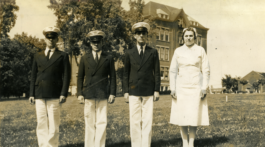It will take place in thousands of Sabbath school classes across North America, in the South Pacific, and in England. When visiting a Sabbath school class, I brace myself. The vast majority of these classes take one of two forms: the lecture class, or the discussion class. To be frank, I dread both of these.
In a lecture class, the teacher does almost all of the talking. They may ask a member to read a verse or two, but other than that, they tell the class what everything means. If they ask questions they are what we call “short answer,” or “fill in the blanks” type questions. The worst of these is the “what” question, as in, “The fear of the Lord is the beginning of ‘what?'” The answers to these questions are either glaringly obvious, as in my example, or a hunt for the precise word that the teacher has in mind. An example of this second type is, “How can we please God?” I remember one teacher particular, where it could take a good five minutes to figure out which of several synonyms he was thinking of.
Classes often devolve into a lecture by one of the class members, or worse yet, dueling lectures
As someone who has taught at every level from grade school to grad school, I can tell you that good lecturers are extremely rare. You may be that one, after all, someone wins the lottery, but the odds are against it. And the chances that your lecture will meet the needs of the audience is vanishingly small. You may know what they need to know, but unless you listen to them, hear their questions and comments, you won’t know how they best receive information they need to know. People who study how we learn tell us that people have at least eight ways of learning. Very few learn through hearing only. So lecturing is not very effective. In addition, the short answer or fill-in-the-blanks type questions do not engage people.
Discussion classes can be excellent, but they rarely are. That’s because all four of the things that Teresa Thompson listed are virtually certain to happen. That is, it is very common that one person will monopolize the so-called discussion, focusing on petty issues, filled with misplaced speculations, and espousing controversial interpretations. In short, they often devolve into a lecture by one of the class members, or worse yet, dueling lectures by two or more class members, complete with implied judgments of another’s Christian experience.
In defense, the most common alternative to these combative fiascoes is that every question is answered in the most tentative and inoffensive way. Either way, very little real learning takes place.
Why is this so common? Because we lose sight of the purpose of having a Sabbath school class at all. We study the Bible in groups so that, by sharing our various perspectives on the text, we can learn to know God and His will better. And in the end, the goal is to equip people, to give them the tools to learn for themselves. What you tell people is easily forgotten, what they discover for themselves they will remember.
A major reason for these failures is that many of us who teach are intimidated by the idea of trying to teach a class. I see it again and again. For many a teacher the major goal is to “fill the time.” Forty minutes stretches out before them like a lifetime. And so we encounter the routine. We do the memory text; we read the introduction. Someone reads the first passage. We discuss the passage for a while. Then we take up the next text. Someone reads it, and then we discuss it. Alternatively, the teacher has someone read the text, then the teacher tells us what it means, perhaps asking one or a few short answer questions. In both cases, repeat over and over, until we run out of time. Everyone sighs with relief.
Guideline One: Don’t lecture unless there is no other alternative.
So here’s the first guideline for conducting a good lesson study: Don’t lecture unless there is no other alternative. For example, if you are conducting a class for an auditorium full of people. In that case, the teacher will have to do most of the talking. Questions and answers are not impossible in that setting, but they are much more difficult.
Guideline Two: Six days study cannot be done in 40 minutes.
Guideline number two: if the authors of the lesson have done their job, the lesson is supposed to take six days to study. That’s a bout six minutes per page. It would take that longer than for an person to look up each text and read it, then read the lesson notes. You will not be able to cover all of that material in forty minutes or even an hour and a half.
Guideline Three: Good discussion engages the whole class, leads to learning, and avoids arguing.
Guideline number three: discussion is great if it is the kind of discussion that engages the entire class, and leads toward learning — not just to arguing. Meandering discussion about every possible association of every text leads nowhere and ends up there.
Guideline Four: People are used to the other ways and will misbehave. Be prepared for that.
Guideline number four: recognize that the “Four things to avoid” that Teresa Thompson listed in her blog are almost certain to happen. Prepare yourself for that. More on that in the next blog.
Guideline Five: Expect the class to have studied before come to class. Proceed accordingly.
Guideline number five: Announce at the beginning of the class, the beginning of the quarter if you are the regular teacher, that you expect the class will study their lesson, and there will be no attempt to repeat that in the class. This is a reward for those who do study, and incentive for those who do not.
In the next blogs, I will outline how to prepare to teach the class, and after that, I will describe how to conduct the class to mitigate and eventually extinguish those undesirable behaviors that disrupt classes.










